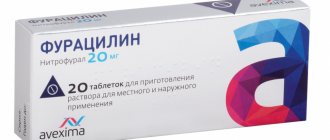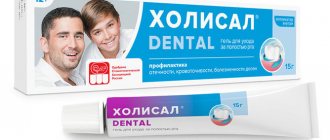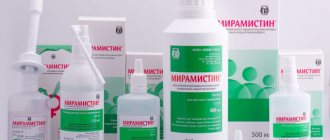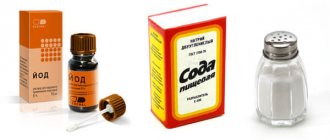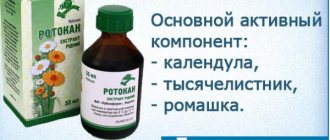One of the most effective methods of treatment for various diseases of the throat and oral cavity is gargling with hydrogen peroxide. Hydrogen peroxide is a clear liquid that more closely resembles water. But in concentrated form it is dangerous for the mucous membranes, so for rinsing it must be diluted.
Oxygen can affect not only bacterial cells, but also the epithelium. Therefore, it is necessary to rinse with the product as carefully as possible.
The action of peroxide is based on the oxidative process carried out by active oxygen. The process affects DNA cells and lipids. As a result, with weak oxidation, the cell is able to recover, and with intense oxidation, it dies.
Using the solution for various diseases
There are a number of diseases for which gargling and rinsing is considered the most effective:
- angina;
- pharyngitis;
- laryngitis;
- stomatitis;
- periodontal disease.
For each disease, it is necessary to select the proportions and duration of treatment.
Tonsillitis and its acute form - sore throat, including purulent one. Sore throat is an infectious disease associated with the inflammatory process in the mucous membrane of the tonsils. Harmful bacteria not only kill normal microflora, but also penetrate into the tissues of the body.
To treat a sore throat, it is recommended to gargle with a solution prepared according to the following recipe:
- in a glass of water you need to dissolve a teaspoon of 3% peroxide;
- You need to pour boiled water into another container;
- First, the solution is treated, and then the throat is rinsed with clean water to remove any remaining medication.
A hot solution sometimes provokes inflammatory processes, and a cold solution is often a factor in the onset of complications. Therefore, gargle only with warm liquid. To obtain the effect, it is necessary to observe the proportions of the solution, since the healing process may be delayed.
Pharyngitis is a disease characterized by inflammation of the pharyngeal mucosa. A hydrogen peroxide solution for gargling can alleviate symptoms.
For pharyngitis, rinsing with liquid has several purposes:
- washing out viruses and bacteria;
- flushing pathogenic mucus from the nasopharynx;
- antiseptic effect on the lesion;
- increasing local immunity;
- acceleration of tissue generation in various forms of the disease.
In case of illness, the procedure should be performed hourly at the beginning of treatment, a little later the number of procedures is reduced to 5 times a day. For chronic pharyngitis, you should gargle twice a day. This frequency is used as a preventive measure.
How to rinse your mouth after removing a wisdom tooth or any other tooth?
So, if you have had a tooth pulled out, what to rinse your mouth with when necessary is the first question. Today, pharmacies have a wide range of specialized antiseptics, while at the same time there are many time-tested folk remedies. Let's consider what you can rinse a tooth with after extraction, and what is strictly prohibited.
Among the solutions produced industrially, in the situation under consideration it is recommended to use:
- Chlorhexidine. Using this product as an example, here is a detailed description of the rinsing procedure: Before rinsing your mouth with chlorhexidine after tooth extraction,
you need to rinse it with warm boiled water: take water into your mouth, hold it and carefully spit it out. - Then put 15-20 ml of solution into your mouth, hold it for 15-30 seconds, and spit. This action should be repeated several times./li>
All of the following solutions should be used in the same way.
- Miramistin;
- Tantum Verde.
In conclusion, we present those means that it is highly not recommended to treat the wound surface of the hole:
- Ethyl alcohol and products containing it;
- Hydrogen peroxide;
- Zelenka or iodine.
Let us note that the surest way to successful wound healing after tooth extraction is to follow all the doctor’s recommendations. At the slightest suspicion of the development of an inflammatory process, you should immediately contact a specialist.
The AktivStom clinic offers you a wide range of paid dentistry services: therapy, surgery, orthodontics (including treatment with Invisalign aligners), orthopedics, implantation, laser dentistry and periodontitis treatment. We employ highly qualified and experienced specialists, our main concern is the result in the form of your healthy and beautiful smile!
Treatment of laryngitis
Laryngitis - in some cases of illness, rinsing with peroxide often has a complex effect:
- relieving sore throat;
- eliminating dry throat;
- improving the patient's well-being.
You need to gargle with peroxide 2-3 times a day for a week.
Stomatitis - the effect of peroxide on the affected areas has the following effects:
- antibacterial cleansing;
- elimination of itching and soreness;
- reduction of swelling.
The course of treatment is two weeks, twice a day.
Periodontal disease is associated with the appearance of ulcers in the mouth. A solution of hydrogen peroxide promotes the healing of formed mucosal defects.
Is it possible to rinse teeth with hydrogen peroxide?
Hydrogen peroxide is quite popular in alternative and official medicine - it is used to treat wounds, put in the nose for a runny nose, and used to rinse the mouth.
In this article we will tell you how suitable hydrogen peroxide is for tooth enamel and how to use hydrogen peroxide for dental and oral health. Text: Editorial staff of Wday.ru October 13, 2016
Recommendations on how to gargle correctly.
Before you start gargling, you need to prepare your throat. To do this, you will need a solution of boric acid, prepared in the ratio: a teaspoon per glass of warm water. Then you need to prepare a peroxide solution. To do this, you need to dissolve a tablespoon of the substance in ½ glass of warm boiled water.
After completing the procedure, the inflamed area should be rinsed with another liquid:
- ordinary boiled and heated water;
- soda solution;
- chamomile decoction;
- sage decoction;
- potassium permanganate solution.
Where are peroxides found?
Carbamide peroxide and hydrogen peroxide are found in popular whitening products:
- in whitening strips;
- in gels for use with mouth guards;
- in applicator pencils;
- in some toothpastes.
When choosing a product, pay attention to the concentration of peroxides. From 10% carbamide peroxide, when it decomposes, 3% hydrogen peroxide is released, therefore the concentration of carbamide peroxide in the bleaching product is always higher. Roughly speaking, a gel with 10% carbamide peroxide is as effective as a gel with 3% hydrogen peroxide.
Indications for completion of therapy
Typically, the course of additional treatment ends only after improvements are noticeable:
- purulent discharge disappears;
- the mucosal epithelium is restored;
- sore throat is eliminated.
Carrying out the gargling procedure in compliance with the basic rules means getting the maximum effect.
Basic recommendations for gargling with hydrogen peroxide:
- A 0.25% hydrogen peroxide solution is suitable for rinsing.
- The optimal temperature for the procedure is 50–60 degrees.
- You can eat food after rinsing only 30 minutes later.
- The best option for complex treatment is the use of rinses as additional therapy.
When treating with peroxide solution, it is necessary to take into account possible side effects and obvious contraindications to the use of the substance.
How to use?
Before gargling with hydrogen peroxide for a sore throat, you should read the instructions:
- Do not use the product if the shelf life has expired.
- Do not use the substance in its pure form to treat the oropharynx. You need to dilute it with water in advance.
- Sometimes a mixture based on water, soda and peroxide is used. But this solution is the most effective for treating gums.
- It is important to adhere to the required dosage in the recipe, as well as observe the frequency of sessions. Abuse of the substance can lead to burns of the mucous membrane and other unpleasant consequences.
- The resulting solution should be used immediately and not left for next time.
- To prepare the medicinal composition, you must use purified water.
- To improve the effect and speed up recovery, you should not arbitrarily increase the dose of the drug or the frequency of rinses. Overdose is considered harmful.
Instead of ordinary hydrogen peroxide, tableted hydroperite can be used. To do this, 1 tablet is diluted in water (150 g).
Contraindications and side effects
Rinsing with peroxide is not recommended for pregnant women, children and people with individual intolerance to the substance. Therefore, you need to take into account the recommendations of doctors:
- When used by pregnant and lactating women, care must be taken to ensure that the solution does not enter the stomach.
- It is important to dilute the substance with water in accordance with the proportions.
- The frequency of rinsing should be agreed with your doctor.
- Treatment of children with this remedy is undesirable, as they may swallow liquid that is dangerous to the stomach.
If the dosage is incorrectly selected, pain and heaviness sometimes occur in the gastrointestinal tract. To eliminate symptoms, you need to reduce the number of drops for preparing the product and take a break in treatment for five days.
The use of hydrogen peroxide is not only effective, but also convenient. If necessary, the solution can be easily placed in a bottle and taken with you on the road.
Forms of stomatitis disease
Neoplasms in the mouth with this disease can be of a different nature, depending on the form of the pathology:
- Catarrhal
is the most common form, which appears due to poor oral hygiene, dental diseases and oral dysbiosis. - The ulcerative
form usually affects patients with stomach ulcers or severe infectious diseases and poisoning. However, ulcerative stomatitis also develops on the basis of catarrhal stomatitis, which was not treated correctly. - Aphthous stomatitis
is accompanied by the formation of aphthae (ulcers) on the oral mucosa. They can be round or oval with a grayish-yellow coating in the center. - Herpetic stomatitis
is very contagious and mainly affects children.
Herpes stomatitis
is provoked by a corresponding virus, which quickly spreads in children's groups, where children play with the same toys or put them in their mouths. - The angular
form is popularly known as “jams”, since it affects only the corners of the mouth due to a lack of iron in the body. - Fungal
is a thrush, as it is provoked by yeast fungi of the genus Candida.
When is a peroxide rinse necessary?
In the presence of such diseases, mouth rinses with hydrogen peroxide are prescribed:
- all types of stomatitis;
- gingivitis in any form;
- periodontitis;
- periodontal disease;
- caries of any degree.
This remedy can be used for many diseases of the oral cavity.
It will be useful to use peroxide as a means of preventing oral diseases. In this case, rinsing should be done no more than once every 7 days. The active substance will eliminate bacteria in places where a toothbrush cannot reach. Hydrogen peroxide is also suitable for treating dentures. It disinfects them completely, without causing even minor damage. Experts can recommend the use of such a product if there is plaque on the teeth that is difficult to reach with a toothbrush and bad breath.
Hydrogen peroxide is also used to eliminate bad breath.
The benefits of this unique remedy are pleasing until side effects appear. Such troubles can be minimized by following the standards for preparation and use of the product.
Important! When combining this product with others, you should maintain an interval of half an hour between their use.
Complete intolerance to the drug is very rare. Also rarely, the drug can provoke cold symptoms and vomiting. In other cases, peroxide does not pose a danger, but consultation with a specialist before use is still required.
- Teeth Whitening Pencil
Hydrogen peroxide in the right concentration is not harmful to the body
Useful actions in the fight against sore throat
If a sore throat was caused by a bacterial infection, this remedy will help cope with the root cause of the problem. It will also provide disinfection of the tonsils, on which bacterial plaque settles. To do this, you need to gargle several times a day.
Having chosen hydrogen peroxide as the main medicine in the fight against sore throat, you should follow a number of recommendations.
- You can only use a solution of 3% concentration.
- After rinsing with peroxide, rinse your mouth with chamomile infusion.
- The permissible frequency of rinsing in this case is up to five times a day at intervals of at least three hours.
Hydrogen peroxide is also used to get rid of sore throats.
If there are ulcers on the tonsils, it is better to opt for lubricating them with high concentration hydrogen peroxide five times a day. This mixture is prepared as follows: dilute 3 tbsp in 100 ml of water. substances of three percent concentration. Dip cotton swabs into the resulting liquid and use them to carefully apply the solution to the tonsils.
Hydrogen peroxide is used to lubricate tonsils to eliminate ulcers
How to properly prepare a rinse solution?
Are there ways to use all the positive properties of hydrogen peroxide, leaving the negative ones behind? Of course, if you strictly follow the dosage and use the drug correctly during therapy. One teaspoon of hydrogen peroxide is diluted in 200 ml of water. This product will not cause any harm.
Note! The main thing is to follow the order in preparation: you need to first pour water and then add peroxide to it. Otherwise, the peroxide may simply oxidize and lose its beneficial properties.
It is important to prepare the rinse solution correctly
About the product
It is a colorless liquid with a metallic odor. Many who decide to use it as a mouthwash find this feature more confusing than others. Hydrogen peroxide can also be recognized by the fact that it completely dissolves in alcohol. If the peroxide has a high concentration, for example, 30-40%, it becomes explosive. Widely used as a solvent.
About hydrogen peroxide
The average person is well acquainted with a three percent peroxide solution in liquid form. This is a diluted version of peroxide, which in the original has a much thicker consistency.
Interesting! Of course, this substance of this concentration is significantly different from its “pharmacy” version. Firstly, it weighs 1.5 times more than ordinary water and requires a higher heating temperature to boil. Secondly, instead of a healing effect, it has a destructive effect: contact of such a substance with the skin is fraught with a chemical burn, which will leave a visible mark.
Application of the product
Medicinal properties
It is a clear, odorless liquid with a slight metallic taste; it dissolves easily in water. If the drug is released in tablet form, it is called hydroperite.
- It has oxidative and reductive properties, is very effective even for purulent inflammation of the ENT organs, destroys viruses, fungi and bacteria, eliminates redness and soothes tissues. The medicinal properties are as follows:
- 1
- Disinfection - thanks to this, viruses, bacteria and yeast-like fungi die, which is why it is used in the treatment of the nose, throat, purulent lesions on the skin, cuts and ulcers.
- 2
Oxygen enrichment - treated tissues are more easily saturated with nutrients and oxygen, which affects rapid recovery and healing. Pain also goes away and the healing process accelerates.
3
Increased blood circulation - after treatment, blood flows better to the affected area, tissues are restored faster.
- 4
- Increasing local immunity - treatment with the product stimulates the body’s own protective functions, increasing the ability of the laryngeal epithelium to independently fight infectious agents.
- 5
Cleansing - when the throat becomes inflamed, the enzyme catalase is formed on the surface of the mucous membrane. The drug comes into contact with it, forming foam, with which particles of pus and dirt, as well as dead tissue, come out of the layers of tissue. Thanks to this action, the mucous membrane heals faster and is cleansed much deeper.
Methods for preparing the solution
It is important to prepare the product correctly to avoid unwanted effects. The preparation method is common for all types of diseases. The concentration depends only on the age of the patient. The oral mucosa of a child is much more susceptible, so it is worth using a less concentrated product.
For an adult, the solution is prepared from one glass of boiled water and one teaspoon of the product. It is important to ensure thorough mixing and the degree of subsequent dilution of the product before starting the procedure. The peroxide must be distributed evenly in the water to achieve the desired consistency.
For children, the rinse solution should be less concentrated
Important! The child, as already mentioned, should make a less concentrated solution. In this case, a teaspoon of peroxide is mixed with one and a half glasses of water.
When using a preventive measure, you should divide the volume of the substance by two with the same volume of water. That is, you need to dilute half a teaspoon of solution per glass of water - for both children and adults. The product is an excellent alternative to special disinfectant rinses.
Hydrogen peroxide is an excellent alternative to special mouthwashes



